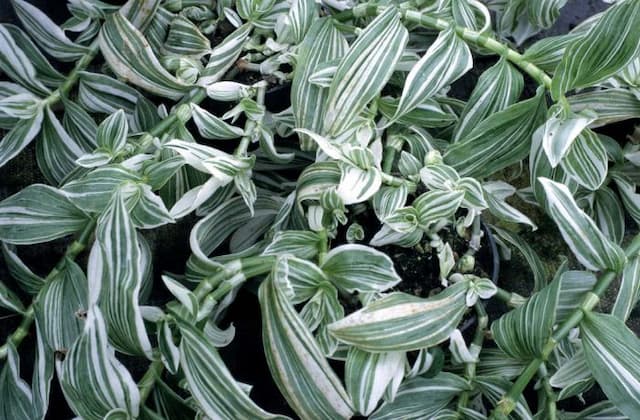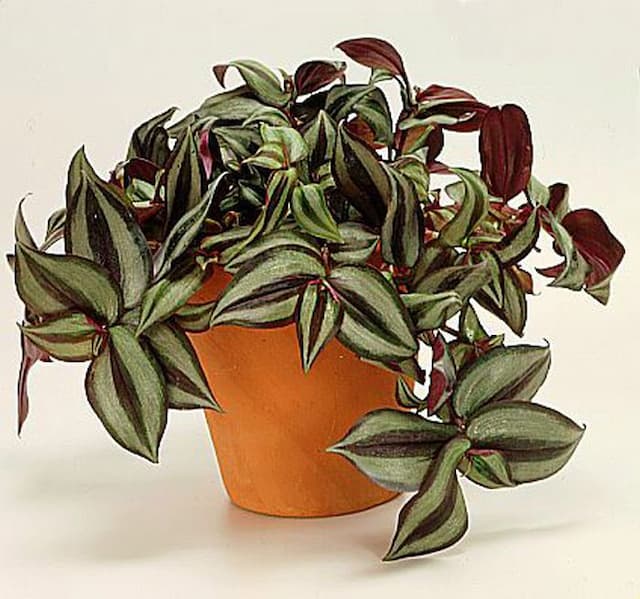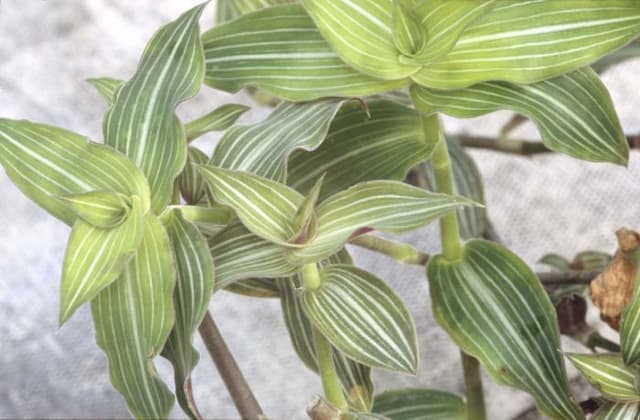Star of Texas Weldenia candida

ABOUT
Weldenia candida, commonly known as Star of Mexico, is a charming perennial with striking features. It boasts a rosette-shaped formation of foliage, displaying long, narrow, and pointed leaves that are dark green in color. These leaves tend to arch gracefully, providing an attractive backdrop for the flowers. The blooms of the Star of Mexico are particularly notable for their intense blue to violet color, which is vivid and eye-catching. They emerge on separate leafless stalks above the foliage, each presenting a star-like structure composed of several rounded petals. The center of the flower contrasts the vibrant petal color with a lighter, almost white, throating, which adds to its ornamental appeal. The flowers, arranged singularly on the stalks, give the plant a delicate and whimsical appearance, especially when they sway gently in the breeze. The overall aesthetic of Weldenia candida is one of lush and exotic beauty, evocative of the habitats where it naturally occurs.
About this plant
 Names
NamesFamily
Commelinaceae
Synonyms
White Star, Weldenia
Common names
Weldenia candida.
 Toxicity
ToxicityTo humans
Weldenia candida, commonly known as Weldenia, is not widely known for being toxic to humans. There is limited information regarding its toxicity, and it is not typically listed among poisonous or harmful plants. However, as with any plant, individual allergies or sensitivities could occur. If you suspect ingestion and have concerns about possible poisoning from any plant, it is always best to consult with a medical professional for proper guidance and treatment.
To pets
Weldenia candida, known simply as Weldenia, does not have a well-documented history of toxicity to pets. The available information does not suggest that this plant is particularly toxic to animals. However, it is always recommended to prevent pets from ingesting plants, as individual animals may have unique sensitivities or allergies. If a pet does ingest Weldenia and shows any signs of distress or illness, it is important to consult a veterinarian immediately.
 Characteristics
CharacteristicsLife cycle
Perennials
Foliage type
Evergreen
Color of leaves
Green
Flower color
Blue
Height
1 foot (0.3 meters)
Spread
2 feet (0.6 meters)
Plant type
Herb
Hardiness zones
9
Native area
Mexico
Benefits
 General Benefits
General Benefits- Aesthetic Appeal: Weldenia candida, commonly known as "Weldenia," adds beauty to gardens with its striking blue flowers and lush foliage, enhancing the visual appeal of a landscape.
- Habitat Support: By producing flowers, Weldenia provides nectar and pollen for a variety of pollinators, including bees and butterflies, supporting local biodiversity.
- Low Maintenance: Weldenia is known to be a low-maintenance plant, requiring minimal care once established, making it a convenient choice for gardeners of all skill levels.
- Drought Tolerance: This plant is well-adapted to dry conditions, making it ideal for xeriscaping and water-wise gardens that aim to reduce the need for irrigation.
- Erosion Control: Weldenia can help stabilize soil and reduce erosion, particularly on slopes or in areas prone to water runoff, due to its root structure.
- Garden Focal Point: Due to its distinctive appearance, Weldenia can serve as a focal point in garden design, drawing the eye and creating interest within a garden space.
 Medical Properties
Medical PropertiesThis plant is not used for medical purposes.
 Air-purifying Qualities
Air-purifying QualitiesThis plant is not specifically known for air purifying qualities.
 Other Uses
Other Uses- Art and Craft – The delicate flowers of Weldenia candida can be used to create natural dyes for fabrics or in pressed flower art projects.
- Garden Borders – It can serve as an attractive border plant given its clumping nature and compact growth habit.
- Educational Tool – Botanical educators can use Weldenia candida to illustrate plant biology topics, such as pollination or plant structure, to students.
- Photography – The plant's bright blue flowers make it a popular subject for photographers and nature enthusiasts.
- Stress Relief – Tending and caring for Weldenia candida can be a soothing hobby that contributes to mindfulness and stress reduction.
- Floral Arrangements – Though not a common cut flower, its blooms could add a unique touch to informal floral arrangements.
- Gifting – Potted Weldenia candida plants can be a special gift for plant lovers and collectors due to their unique appearance.
- Rock Gardens – This plant is well-suited for rock gardens, where it can thrive in well-draining soil and with minimal care.
- Conservation Education – Can be used for conservation education, highlighting the importance of plant diversity and preservation.
- Ecological Research – Weldenia candida can be used in ecological studies to understand the plant's role in its native habitat and its interactions with other species.
Interesting Facts
 Feng Shui
Feng ShuiThe Weldenia is not used in Feng Shui practice.
 Zodiac Sign Compitability
Zodiac Sign CompitabilityThe Weldenia is not used in astrology practice.
 Plant Symbolism
Plant Symbolism- Rarity: Weldenia candida, commonly known as simply Weldenia, is not a commonly known plant, making it a symbol for the rare and unique aspects of nature.
- Purity: Its white flowers can symbolize purity and innocence, reflecting its unblemished and candid appearance.
- Resilience: Since Weldenia can thrive in rocky areas with good drainage, it can represent resilience and the ability to overcome challenging environments.
- Modesty: Despite its beauty, Weldenia maintains a low-growing habit, which can reflect the quality of modesty or humility in a person or situation.
 Water
WaterWeldenia candida, commonly known as the Trailings Weldenia, prefers evenly moist soil and should be watered when the top inch of soil feels dry to the touch. Typically, this might mean watering once every week, but this schedule can vary depending on factors such as temperature, light, and humidity. When watering, use room-temperature water and thoroughly saturate the soil until water runs out of the bottom of the pot, but avoid letting the plant sit in water. Depending on the size of the pot, this may require approximately 16 to 32 ounces of water each time.
 Light
LightTrailings Weldenia thrives in bright, indirect light. It's best to place it in a location where it can receive a lot of light without being exposed to the harsh afternoon sun, such as a few feet away from a south-facing window or near an east or west-facing window with some shade.
 Temperature
TemperatureThe Trailings Weldenia prefers warm temperatures ranging between 60 and 80 degrees Fahrenheit. It can survive in temperatures as low as 50 degrees Fahrenheit but should not be exposed to temperatures below that. Ideal growth occurs within the specified warm range, avoiding any sudden drops or spikes in temperature.
 Pruning
PruningTrailings Weldenia benefits from occasional pruning to maintain its shape and encourage denser growth. Pruning is best done in the spring or early summer when the plant is actively growing. Remove any dead or damaged leaves as needed throughout the year to keep the plant looking tidy and to encourage healthy growth.
 Cleaning
CleaningAs needed
 Soil
SoilTerrazo plant thrives in well-draining soil with a pH of about 6.0 to 7.5. A mix of two parts peat moss, one part perlite, and one part coarse sand is ideal for this plant to ensure proper drainage and aeration.
 Repotting
RepottingTerrazo should be repotted every 2 to 3 years or when it outgrows its current pot. Use a container only slightly larger than the previous one to avoid overwatering issues.
 Humidity & Misting
Humidity & MistingTerrazo prefers moderate to high humidity levels, ideally between 50% to 70%. Avoid placing it in excessively dry environments.
 Suitable locations
Suitable locationsIndoor
Place Terrazo in bright, indirect light indoors and moderate humidity.
Outdoor
Outdoor cultivation of Terrazo requires dappled shade and shelter from harsh sun.
Hardiness zone
9-11 USDA
 Life cycle
Life cycleWeldenia candida, commonly known as Mexican Blue Stars, begins its life as a seed that germinates in well-draining soil with consistent moisture and partial shade. The seedlings develop into rosettes of elongated, fleshy leaves, and once mature enough, they produce short stalks with clusters of star-shaped blue flowers. After pollination, these flowers develop into capsules containing seeds. The plant typically flowers in early summer and may persist in blooming for several weeks. Once the seeds are mature, they are dispersed by various mechanisms, potentially giving rise to new plants. Throughout its life, Weldenia candida forms clump-like structures as it spreads, commonly enhanced by division of the clumps for propagation.
 Propogation
PropogationPropogation time
Spring
Propogation: Weldenia candida, commonly known as the Star Flower, is typically propagated through division, which is the most popular method for this plant. This process is best done in the spring or early summer when the plant is actively growing. To propagate by division, gently remove the plant from its container or carefully dig it up if planted in the ground. Shake off the excess soil from the roots and using a clean, sharp knife or spade, divide the plant into sections, making sure each section has a good portion of roots. Replant the divisions at the same depth they were growing before, water them well, and maintain consistent moisture as they establish themselves. This technique is quite straightforward and helps to create new plants that retain the characteristics of the parent plant while rejuvenating overcrowded clumps.



